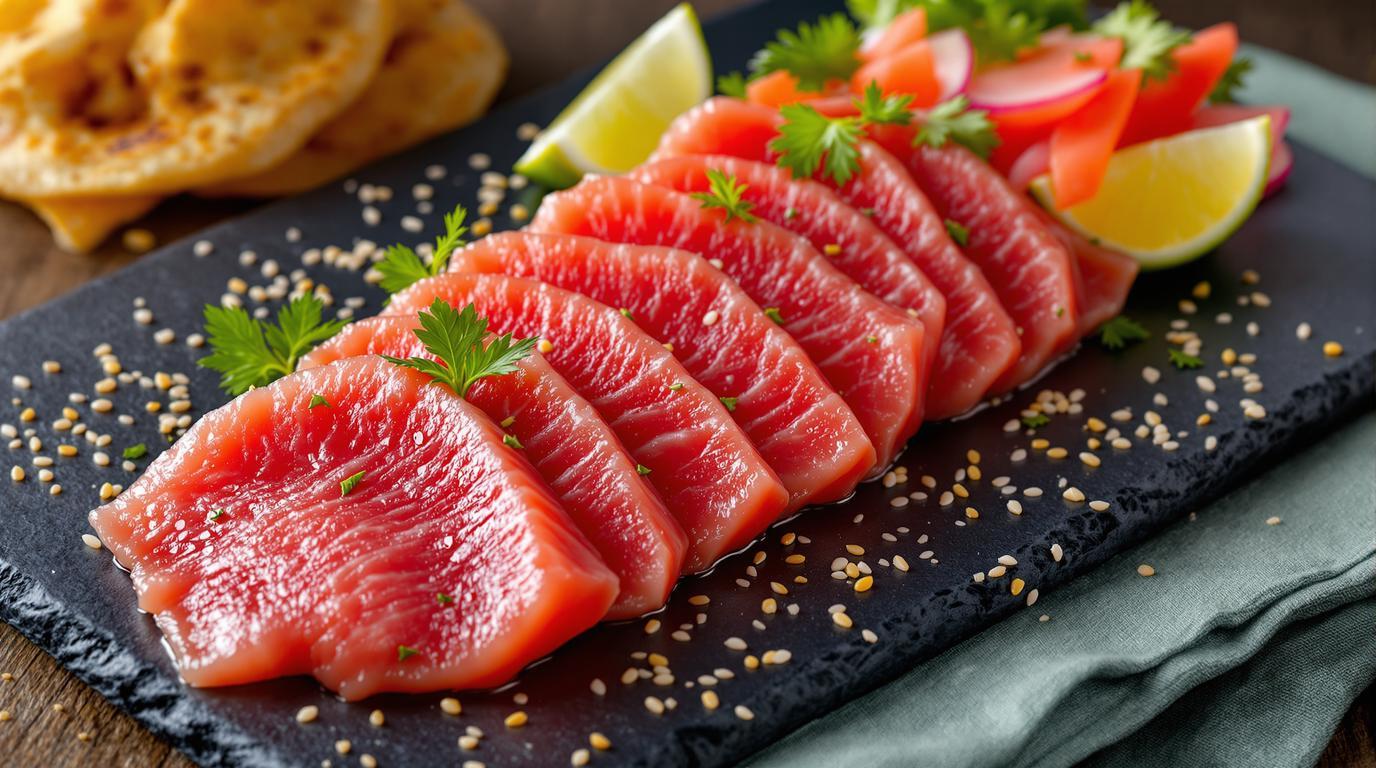I’ll never forget the first time I prepared tuna sashimi on Mexico’s Pacific coast. The local fishermen had just delivered gleaming yellowfin tuna, its ruby flesh practically translucent when sliced. What transformed this simple preparation into something magical wasn’t elaborate technique—it was the marriage of Japanese precision with vibrant Mexican flavors. This dish bridges cultures in the most delicious way possible, proving that sometimes the most authentic traditions are those born from cultural exchange.
The Story
Sashimi de Thon Frais (Fresh Tuna Sashimi) represents a beautiful culinary crossroads. While “thon frais” reflects French terminology, the preparation I’m sharing today draws inspiration from Mexican coastal communities where Japanese immigrants introduced sashimi techniques that were then brilliantly reimagined with local ingredients. The brilliance lies in its simplicity—pristine fish elevated by bright citrus, gentle heat from chiles, and the freshness of herbs. Unlike traditional Japanese sashimi where purity reigns supreme, this version celebrates bold flavor harmonies.
During my time at a seafood restaurant in Ensenada, I learned that the key to this dish isn’t complexity but rather respecting each element—especially the star ingredient: impeccably fresh tuna.
Ingredients Spotlight
For 4 servings:
- 1 lb (450g) sashimi-grade tuna (yellowfin or bluefin), preferably center-cut loin
- 3 tablespoons premium soy sauce
- 2 tablespoons fresh lime juice (from 2 limes)
- 1 tablespoon fresh orange juice
- 1 teaspoon freshly grated ginger
- 1 serrano or jalapeño chile, seeded and finely diced
- ¼ cup cilantro leaves, roughly chopped
- 3 tablespoons thinly sliced spring onions
- ½ teaspoon toasted sesame seeds
- Crisp tostadas or saltine crackers, for serving
- Lime wedges, for serving
Step-by-Step Guide
1. Prepare the tuna: Using your sharpest knife, slice the tuna against the grain into ½-inch thick rectangles. For optimal texture, chill your knife blade before cutting. Place slices on a cold plate and return to refrigerator while preparing other components.
2. Create the dressing: In a small bowl, whisk together soy sauce, lime juice, orange juice, and grated ginger until well combined. The citrus-soy balance should be harmonious—neither too salty nor too acidic.
3. Assemble: Just before serving, arrange tuna slices on chilled plates. Drizzle with the prepared dressing (about 1 tablespoon per serving).
4. Garnish: Scatter the diced chile, cilantro, and spring onions over the tuna. Finish with a light sprinkle of sesame seeds.
5. Serve: Offer immediately with tostadas or saltines and lime wedges on the side.
Expert Techniques
The difference between good sashimi and exceptional sashimi lies in the details. When slicing tuna, maintain a 45-degree angle with your knife to increase the surface area that contacts your palate. This subtle technique enhances both texture and flavor delivery.
Chef’s Note: Temperature contrast is crucial here. The plate should be cold, the fish cool, and the dressing at room temperature. This creates a sensory awakening that heightens each flavor. I learned this principle at a small family restaurant in Puerto Vallarta, where the chef insisted this temperature interplay was her grandmother’s secret.
Timing is everything with this dish—dress the tuna no more than 3 minutes before serving. The acidity in the citrus will begin to “cook” the proteins, changing both texture and color if left too long. You want to preserve that pristine, silky mouthfeel that makes sashimi so luxurious.
Presentation & Pairing Ideas
For a stunning presentation, arrange the tuna slices in a fan pattern on a black plate to showcase their vibrant color. If you’re feeling adventurous, try serving atop a thin slice of watermelon radish for added color and a subtle peppery note.
This dish pairs beautifully with a crisp Sauvignon Blanc or, for something unexpected, a slightly chilled craft lager with citrus notes. For a non-alcoholic option, try sparkling water infused with yuzu or cucumber—the effervescence cleanses the palate between bites.
For a seasonal variation in summer, add diced mango or watermelon to the garnish. In winter, replace serrano with a tiny amount of wasabi paste and add supremed blood orange segments for complexity.
The beauty of this dish lies in its adaptability—trust your palate and make it your own. Perhaps adding microgreens, a drop of chile oil, or even a whisper of smoked salt. Remember, the most memorable dishes aren’t just recipes followed—they’re expressions of your own culinary voice. 🌊🐟✨
